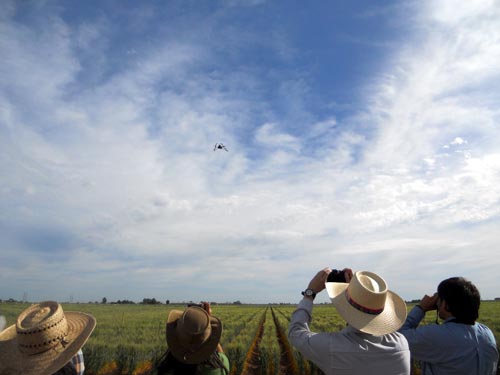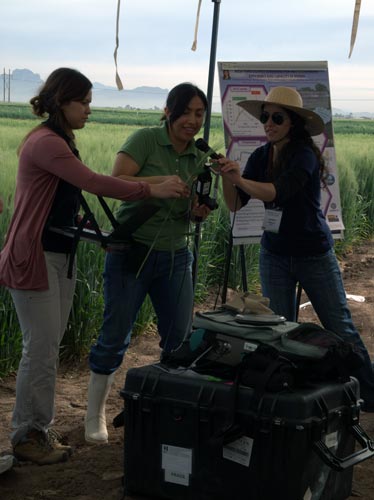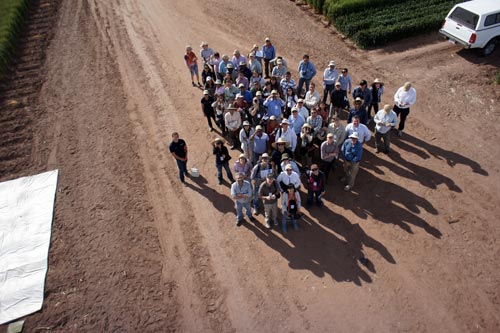 Over 100 stakeholders, scientists, and students from 28 countries were welcomed in Obregon, Mexico, by John Snape, CIMMYT Board of Trustees member, as he opened the 3rd International Workshop of the Wheat Yield Consortium (WYC). The meeting sponsored by SAGARPA (through MasAgro) was held at the Campo Experimental Norman E. Borlaug (CENEB) near Ciudad Obregon, Sonora, Mexico, during 5-7 March 2013.
Over 100 stakeholders, scientists, and students from 28 countries were welcomed in Obregon, Mexico, by John Snape, CIMMYT Board of Trustees member, as he opened the 3rd International Workshop of the Wheat Yield Consortium (WYC). The meeting sponsored by SAGARPA (through MasAgro) was held at the Campo Experimental Norman E. Borlaug (CENEB) near Ciudad Obregon, Sonora, Mexico, during 5-7 March 2013.
Following the welcoming speech, Vicky Jackson (BBSRC) updated stakeholders on the current status of the new Wheat Yield Network (WYN) that supercedes the WYC with a plan to expand the funding basis and research agenda. CIMMYT wheat physiologist Matthew Reynolds then provided an overview of the current wheat yield situation: “Although production has increased steadily, the price of wheat continues to increase at a considerably faster rate.” WYN is an international network of scientists working together to address these issues. As wheat productivity will be crucial for food security in the future, WYN aims to achieve a 50% increase in genetic yield potential of wheat within 20-25 years through (1) increasing crop biomass by improving photosynthetic capacity, (2) optimizing partitioning to maximize agronomic yield, and (3) incorporating improved yield potential traits into elite breeding lines adapted to wheat agro-ecosystems worldwide. “We are establishing a balanced research portfolio with a strong output oriented agenda to provide solutions for wheat farmers and consumers throughout the developing world,” said Reynolds.
 The first day was dedicated to over 20 presentations covering all three major research areas. Chaired by Bill Davies (Lancaster University), the session on crop biomass improvement covered topics such as optimizing leaf and canopy photosynthesis and photosynthetic potential of spikes. Gemma Molero (CIMMYT) pointed out that while the importance of spike photosynthesis has been recognized for 50 years, no breeding programs has yet tried to systematically improve this trait. This session was followed by presentations on partitioning optimization chaired by Martin Parry (Rothamsted Research), and the day was concluded with updates on breeding for yield potential and research support platforms which was chaired by Bill Daniel Calderini (Universidad Austral de Chile).
The first day was dedicated to over 20 presentations covering all three major research areas. Chaired by Bill Davies (Lancaster University), the session on crop biomass improvement covered topics such as optimizing leaf and canopy photosynthesis and photosynthetic potential of spikes. Gemma Molero (CIMMYT) pointed out that while the importance of spike photosynthesis has been recognized for 50 years, no breeding programs has yet tried to systematically improve this trait. This session was followed by presentations on partitioning optimization chaired by Martin Parry (Rothamsted Research), and the day was concluded with updates on breeding for yield potential and research support platforms which was chaired by Bill Daniel Calderini (Universidad Austral de Chile).
The following day participants had the opportunity to visit the Mexican Phenotyping Platform (MEXPLAT) located at CENEB for a field day and presentations on wheat yield potential and wheat yield and stress adaptation. There they had the chance to see CIMMYT’s first blimp, which was launched during last year’s workshop, and observe the new airborne remote sensing platform AscTec Falcon 8 in action, as well as other tools used by CIMMYT PhD students and physiologists in their research. “For me all the presentations were interesting,” said Yosra Ellemsi, agronomist and CIMMYT conservation agriculture program trainee from Tunisia, showing that the workshop did not target only physiologists. “I was particularly interested in the presentation of Sean Thompson who used the ground penetrating radar as a phenotyping tool for roots. This tool is fascinating firstly because it allows for nondestructive ground penetration, and secondly because it could help breeders to phenotype and select optimal root biomass in breeding populations.” At the end of the program, Davies thanked Reynolds and his team for organizing the workshop and for their work to achieve the goals of WYC: “We believed in this when we first started talking about it and you have moved it forward. This workshop is a great opportunity to discuss the latest developments in the field as you always get to talk to very interesting scientists.

 Capacity development
Capacity development 
